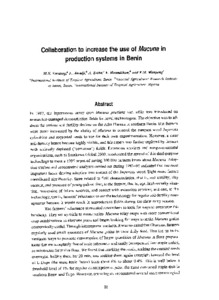| dc.contributor.author | Versteeg, M. |
| dc.contributor.author | Amadji, F. |
| dc.contributor.author | Eteka, A. |
| dc.contributor.author | Houndekon, V.A. |
| dc.contributor.author | Manyong, Victor M. |
| dc.date.accessioned | 2019-12-04T11:23:34Z |
| dc.date.available | 2019-12-04T11:23:34Z |
| dc.identifier.citation | Versteeg, M., Amadji, F., Eteka, A., Houndekon, V.A. & Manyong, V. (1998). Collaboration to increase the use of Mucuna in production systems in Benin. In D. Buckles, A. Etèka, O. Osiname, M. Galiba and G. Galiano, Cover crops in West Africa: contributing to sustainable agriculture= Plantes de couverture en Afrique de l'Ouest: une contribution à l'agriculture durable. Ottawa, Canada: International Development Research Centre, (p. 33-43). |
| dc.identifier.isbn | 0-88936-852-X |
| dc.identifier.uri | https://hdl.handle.net/20.500.12478/4037 |
| dc.description.abstract | In 1987, the leguminous cover crop Mucuna pruriens var. utilis was introduced on researcher-managed demonstration fields for novel technologies. The objective was to ad-dress the serious soil-fertility decline on the Adja Plateau in southern Bénin. But farmers were more impressed by the ability of Mucuna to control the rampant weed Imperata cylindrica and requested seeds to use for their own experimentation. However, a clear soil-fertility bonus became highly visible, and this aspect was further explored by farmerswith seriously depleted ("comatose") fields. Extension services and non-governmental organizations, such as Sasakawa Global 2000, accelerated the spread of this dual-purpose technology to meet a 1995 target of having 100 000 farmers know about Mucuna. Adoption studies and econometric analyses carried out during 1993-95 indicated that the most important factor driving adoption was control of the Imperata weed. Eight more factors contributed significantly: three related to field characteristics, that is, soil fertility, clay content, and presence of young palms; four, to the farmer, that is, age, land-security situation, possession of fallow reserves, and contact with extension services; and one, to the technology, that is, farmers' reluctance to use the technology for regular soil-fertility management because it would result in unproductive fields during the short rainy season. The farmers' reluctance stimulated researchers to look for ways to overcome this handicap. They set up trials to rotate maize-Mucuna relay crops with more conventional crop combinations in alternate years and began looking for ways to make Mucuna grains economically useful. Through interregional contacts, it was revealed that Ghanaian farmers regularly used small quantities of Mucuna grains in their daily food. This led us to investigate ways to promote consumption of larger quantities of Mucuna in flour preparations that are acceptably free of toxic substances and easily incorporated into staple dishes, as substitutes for maize flour. We found that cracking the seeds, soaking the cracked seeds overnight, boiling them for 20 min, and soaking them again overnight lowered the level of L-Dopa (the main toxic factor) from about 6% to about 0.4%. This is well below threshold level of 1% for regular consumption of pâte, the most consumed staple dish in southern Bénin and Togo. However, toxicologists recommend several more toxicological tests for other possible antinutritional factors before the flour is launched for large-scale consumption. Observation trials using Mucuna grains for animal feed for pigs and goats are under way in Bénin, but no results are available yet. Other niches for Mucuna adoption were observed in northern Bénin: use of Mucuna-maize relay crops for hay production (adopted by many Fulani herdsman around Nikki in eastern Borgou province) and for Strigo, control. The essential impact of farmer interaction on the course of experimentation, results, and adoption is also highlighted in this paper. |
| dc.description.abstract | L'histoire du Mucuna a commencé en République du Bénin en 1987, lorsque le Mucunapruriens var. utilis a été introduit aux paysans du village de Zouzouvou sur le plateauAdja. Bien qu'au départ le Mucuna ait été présenté aux paysans pour restaurer la fertilitédes sols, ceux-ci ont été plus impressionnés par la capacité de cette plante à étouffer lechiendent ( Imperata cylindrica ). En une saison, le Mucuna semé en association avec lemaïs de 3 à 4 semaines après le semis du maïs a ramené la densité du chiendent de270 plantes m~2 à 32 plantes m""2. La capacité du Mucuna à restaurer la fertilité du solétait également évidente. Le rendement grain du maïs produit après l'utilisation duMucuna était de 70 % plus élevé que le témoin sans Mucuna. Les perspectives d'adoptionde la technologie du Mucuna se sont accrues grâce à deux facteurs : ( 1 ) la rotation descultures maïs-Mucuna avec les combinaisons conventionnelles pendant des annéesalternées, étant donné que la culture du Mucuna sur un terrain ne permet pas l'utilisationde ce terrain pendant la seconde saison de pluie ; et ( 2 ) le développement des méthodesde réduction de la substance toxique L-dopa contenue dans les graines de Mucuna, pouraccroître la valeur nutritionnelle pour les hommes et les animaux. La production duMucuna et la suppression de l'infestation de Striga dans les chanps sont les nouvellesvoies pour son adoption dans le nord du Bénin. |
| dc.language.iso | en |
| dc.language.iso | fr |
| dc.subject | Mucuna Pruriens Var. Utilis |
| dc.subject | Weed |
| dc.subject | Legumes |
| dc.subject | Maize |
| dc.title | Collaboration to increase the use of Mucuna in production systems in Benin |
| dc.type | Book Chapter |
| cg.contributor.crp | Policies, Institutions and Markets |
| cg.contributor.affiliation | nternational Institute of Tropical Agriculture |
| cg.coverage.region | Africa |
| cg.coverage.region | West Africa |
| cg.authorship.types | CGIAR and developing country institute |
| cg.iitasubject | Maize |
| cg.iitasubject | Weeds |
| cg.iitasubject | Grain Legumes |
| cg.accessibilitystatus | Limited Access |
| local.dspaceid | 99323 |

